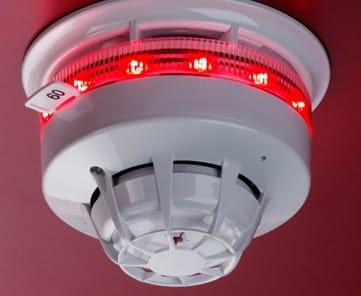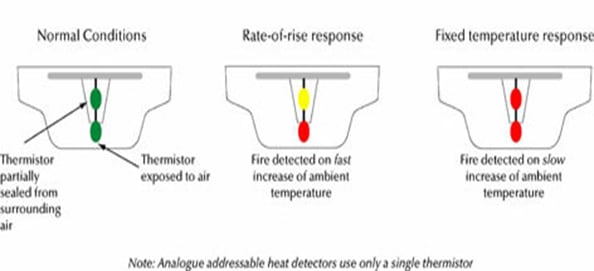What is a heat alarm? #
As we have mentioned, it is a special safety device that responds to a rise in temperature and gets activated in case of a fire. Unlike smoke detectors, they do not respond to smoke and thus are designed to save property rather than life. Thanks to a heat alarm you can get extra time to put off a fire or evacuate people from a building. To check out the uses of fire alarms check here.
How does a heat detector alarm work? #
Heat sensors trigger an alarm by either melting a low fusing alloy or bending a bimetallic strip.
Depending on its construction, a heat sensor alarm can be electronic or mechanical (mechanical alarms, in their turn, can be pneumatic or bi-metallic). An electronic heat detector alarm contains a thermistor which changes resistance as the temperature increases.

LED indicators on electronic heat detectors blink to indicate proper standby operation.
Bi-metallic mechanical alarms have a strip which is made of two different metals. Due to a change of temperature metal distorts and closes a contact. Pneumatic detectors consist of a chamber filled with air and a movable diaphragm into which the chamber is put. As the temperature rises, the chamber with air expands and deforms the diaphragm. This triggers a set of contacts that alert of the danger.
Some heat detector alarms respond to the rapid increase in temperature. They are known as rate-of-rise sensors (ROR). When the temperature starts rapidly increasing by about 12°F – 15°F per minute, the alarm is activated. It is important to make sure that ROR alarms are not installed in the areas with a natural rapid increase in temperature that goes above the trip point, such as attics.
Fixed-temperature heat sensors, on the other hand, alert to the dangerous situation when a particular temperature is exceeded. They usually get activated when the temperature rises above 135 degrees. Fixed-temperature alarms are considered to be less reliable than ROR alarms because of the thermal lag. In other words, the detector may alarm you when the actual temperature is much higher than the pre-set threshold.

Application of heat alarms #
Heat alarms are mostly utilized in the areas where smoke alarms cannot be installed. For example, kitchens are regularly filled with smoke, garages have fumes, attics might have an excessive number of particles of dust or moisture, etc. Installing smoke alarms in the above-mentioned areas may cause false alarms and is unpractical from the standpoint of maintenance.
It is important to remember that heat sensor alarms are not designed to save human life. They won’t get activated in case something burns slowly and generates smoke and carbon monoxide. Kitchens, garages, warehouses, attics, electrical closets, etc., are the facilities where heat detector alarms can be installed and beneficially used.
Prior to installing a heat alarm think of the area where you are going to use it. Consider such factors as fluctuation of temperature, source of power, and whether you need a wireless or a wired device. Remember that installation of a heat alarm might not suffice to protect people’s lives, and that you would need to get a smoke alarm that must to be installed in or near the sleeping area.

